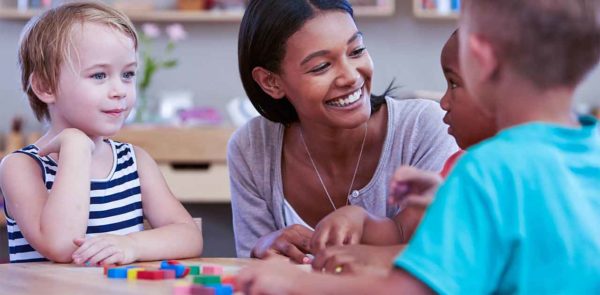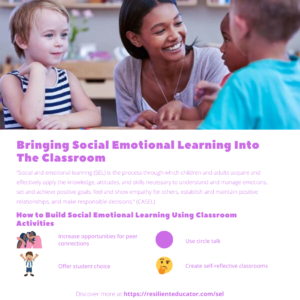
Social-emotional learning activities have made their way into advisory classrooms across the country, but they shouldn’t just live there. Content-area classrooms are important epicenters for social-emotional learning, and when we incorporate SEL strategies into academic time, the potential for student growth is impressive.
Adapting to lockdowns and school closures, while quickly migrating to online learning, has caused a lot of stress for students. We know that stress leads to trauma. It’s important for teachers to incorporate social and emotional considerations into their curriculum, whether the medium is online or in-person. David Adams, the CEO of Urban Assembly, writes in an article that “young people with strong social and emotional skills are better equipped to cope with challenges, overcome trauma and engage academically.” SEL aims to integrate social and empathy awareness with academic development.
Here’s how to get started with implementing SEL in the classroom.
What is SEL?
According to The Collaborative for Academic, Social, and Emotional Learning (CASEL), “social and emotional learning (SEL) is the process through which children and adults acquire and effectively apply the knowledge, attitudes, and skills necessary to understand and manage emotions, set and achieve positive goals, feel and show empathy for others, establish and maintain positive relationships, and make responsible decisions.” Copious studies show that SEL leads to extensive and positive outcomes for students. One group of researchers (Kautz, Heckman, Diris, Bas ter Weel, & Borghans, 2014) found that SEL “increases high school graduation rates, postsecondary enrollment, postsecondary completion, employment rates, and average wages.”
It also decreases “dropout rates, school and classroom behavior issues, drug use, teen pregnancy, mental health problems, and criminal behavior.” Those are some powerful results. Here are a few ways to embed SEL into your academic teaching time.
Increase opportunities for peer connections
One way to incorporate SEL into content-class time is to offer opportunities for peer engagement. Get students talking and interacting positively. Create situations for students to display empathy. Let’s say you’re working on a writing assignment. Allow students to work together to brainstorm or peer edit. Or, if you’re reading a story, sit in a circle or in small groups and let students discuss how they empathize with a character’s conflict. In a math class, let students work together to solve a problem. Have a class discussion after a test to discuss how everyone worked through it.
Use circle talk
Circle Talk isn’t just for advisory classes or counseling sessions. Circles are a powerful tool for academic classes that help students learn by listening to their peers, contributing to discussions, and developing and expressing empathy. Circles can be used in an English Language Arts classroom for things like book talks, text reviews, exploring meaning or analysis. In a science classroom, students can use circles to review notes or vocabulary, or discuss prior knowledge of a new topic. In math, circles can be used for things like sharing thoughts on how to solve a problem, sharing techniques for remembering concepts, reviewing material, or learning new terms. In social studies, circles can be used to analyze a primary source document, discuss a current event or ethical issue, or examine prior knowledge of a historical event. (Academic Peace Circles: Diagnose, Create, Understand, Review Cordula Kennell Avon High School English Department)
Offer student choice
An important component of SEL is teaching students how to make responsible decisions and set goals. When students are able to make choices in class, it empowers them to learn to be responsible and to cultivate positive autonomy. When students make decisions, they have more of a stake in living up to their choices. You can start small by offering students choices of what to read or a choice between tasks. Look at a calendar together and let your students choose a deadline they can manage that works for you. Even small decisions can be an incredibly meaningful learning tool within school’s structure, which typically offers little student choice.
Engage in self-reflection
When students have the time and space to stop and think about their decisions, actions, or progress, they are able to develop the skills to manage their emotions, plan for their future, and make healthy decisions. “Teachers who promote reflective classrooms ensure that students are fully engaged in the process of making meaning. They organize instruction so that students are the producers, not just the consumers, of knowledge. To best guide children in the habits of reflection, these teachers approach their role as that of “facilitator of meaning making,” say authors Arthur L. Costa and Bena Kallick in Learning and Leading with Habits of Mind. After an assignment, let students reflect upon their work by writing or engaging in a circle talk with their peers. Ask students to give themselves a grade and explain their choice. Provide opportunities for students to reflect on their academic habits throughout a semester.
Model social-emotional skills through your actions
Students learn a lot by watching the adults in their lives. As teachers, we are role models who spend a great deal of time with our students. Therefore, we must be models of the social skills we preach. This includes managing anger, collegial interactions, constructive criticism, and stress, while displaying honesty and integrity. “By heightening adults’ mindfulness of the impact their words and actions are having, schools can intentionally take advantage of daily interactions to further develop students’ social and emotional competencies,” according to the National Commission on Social, Emotional, and Academic Development. “Managing emotions, setting and achieving goals, expressing empathy, maintaining positive relationships, and making responsible decisions are as relevant for how staff work together as they are for fostering the social and emotional development of students.” As teachers model positive interactions, students will emulate these behaviors in their own peer interactions.
For more on SEL, check out these resources:
- Social Emotional Learning – The Magic of Circle Talk
- Why We Really Need SEL (Social Emotional Learning) Now
- The Role of Empathy in Teaching Social Emotional Skills
- How Can Teachers Cultivate Social Connection and Empathy in the Classroom?
- Mindfulness Activities for the Elementary Classroom
- SEL Strategies for Online Classrooms
Jennifer L.M. Gunn spent 10 years in newspaper and magazine publishing before moving to public education, where she has been for nearly a decade. She is a curriculum designer and public high school educator in New York City. Jennifer is the creator of Right to Read, a literacy acceleration program for urban adolescent youth that’s steeped in social justice. She is an education writer and is co-founder of the annual EDxEDNYC Education Conference, which won the New York City Department of Education Excellence in School Technology Award this year. Jennifer regularly presents at conferences on the topics of adolescent literacy, leadership, and education innovation. Follow Jennifer online at www.jenniferlmgunn.com or on Twitter.
Categorized as: Tips for Teachers and Classroom Resources
Tagged as: Bullying and Bully Prevention, Engaging Activities, Professional Development, Trauma and Resilience

